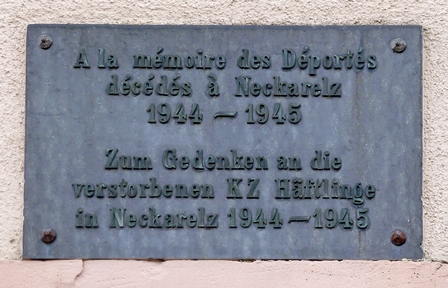"Goldfish" changed the face of the Elz Estuary
The Neckarelz Concentration Camp

The Neckarelz Concentration Camp came into existance in the spring of 1944, as a result of a strategic factory being transferred to Obrigheim /Neckar.
The factory being referred to was Germany´s largest engine factory, the Daimler-Benz Engine Plant Ludwigsfelde/Genshagen (greater area of Berlin). After an air attack in March 1944, the factory was to be made"bomb-proof" and relocated underground.
The gypsum mine near Obrigheim/Neckar was chosen as the new location. The project was given the code name "Goldfish", and the construction site management was led by the SS.
The SS put together a work-force of concentration camp prisoners for both the development and the reconstruction of the gallery system. The first 500 men were housed in the Neckarelz elementary school. The school was turned into a concentration camp.
The elementary school is about 2km (1,2 miles) away from the gypsum mine. The prisoners marched through the village on their way to the mine.
The prisoners converted the school into a concentration camp. They erected a barbed wire fence around the compound, carpentered plank bunk beds for the six classrooms, and built barracks and other buildings in the schoolyard.
After the war, the Neckarelz concentration camp was once again used as a school. It was preferred that the concentration camp`s past be best kept silent. A small plaque on the school house was the only reminder. This plaque was placed by French concentration camp survivors in 1953.
"Goldfish" Armament Factory
The relocated Daimler-Benz Motor Works Ludwisfelde/Genshagen( from the greater area of Berlin) to the Neckar, was hidden behind the code name "Goldfish". In 1944, the largest German aircraft engine factory was completely relocated to the underground Gypsum mine in Obrigheim where it was reassembled.
Concentration camp prisoners were used as construction workers. For the actual engine production,"free workers", but especially "foreign workers" from various countries were used.
The concentration camp prisoners were required to set up the construction site beginning in the middle of March, 1944. They had to free the gallery corridors from boulders and mud, and cement 50,000 square meters of floorspace. Outside the gallery, they set up further buildings and facilities.
The first machines and workers arrived on June 26,1944. In total, approximately 5,000 "Loyal followers" (free workers and "foreign workers" - including women) poured into the region.
On April 2, 1945 American troops occupied the Neckar Valley and immediately investigated the underground factory. After the war, the seized gypsum mine was returned to the Portland Cement Company. Today, gypsum is still mined from the hills on the banks of the Neckar.
The entire history of the underground armament factory "Goldfish"
Forced labour Camp
During the Nazi régime in Germany, forced labour was widespread. Especially during the second half of the war, when all those Germans who were fit for military service were conscripted.
Approximately 5,000 forced labourers worked for the "Goldfish" armament project. These forced workers were not concentration camp prisoners but rather "east" and "west" workers, prisoners of war, Italian military detainees or German convicts.
Learn more about the Forced Labour Camps in Mosbach.
The Relocation of the Headquarters
The Natzweiler Concentration Camp moves to the Neckar
The Natzweiler-Struthof concentration camp was developped near a discovery of pink granite in the Vosges mountain range in France. Beginning in 1943, more and more satellite camps were being developed directly near the arms manufacturers. The number of prisoners began to greatly increase. In 1944, more than 50 satellite camps on both sides of the Rhine belonged to Natzweiler, including all the camps within the Neckar concentration camp complex.
The main camp was evacuated at the beginning of September 1944, as a result of the advancement of the allied armed forces. The camp prisoners were relocated to the Dachau concentration camp.
The annex camps on the left side of the Rhine were dissolved, the prisoners of the camps on the right side of the Rhine displaced. At the same time, the SS opened almost 20 further satellite camps in Baden and Wuerttemberg in the last months of the war.
The headquarters of the main camp moved to the Neckar in November 1944. It was divided amongst the villages of Guttenbach, Binau and Neunkirchen. The name "Natzweiler Concentration Camp" remained, although the location no longer existed.
The miserable conditions in the satellite camps on the right side of the Rhine worsened during the winter of 1944/45 - due to the cold, as well as the horrible provisioning as a result of the war situation.
The "Natzweiler concentration camp" was ultimately dissolved in March and April 1945. The SS sent 20,000 concentration camp prisoners in "sick trains" and on "death marches" to the Dachau, Buchenwald, Bergen-Belsen concentration camps, and toward the Alps. Thousands lost their lives in the last weeks of the war.
A more detailed report:
The Relocation of the Headquarters to the Neckar.

